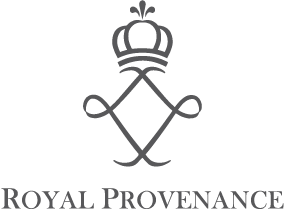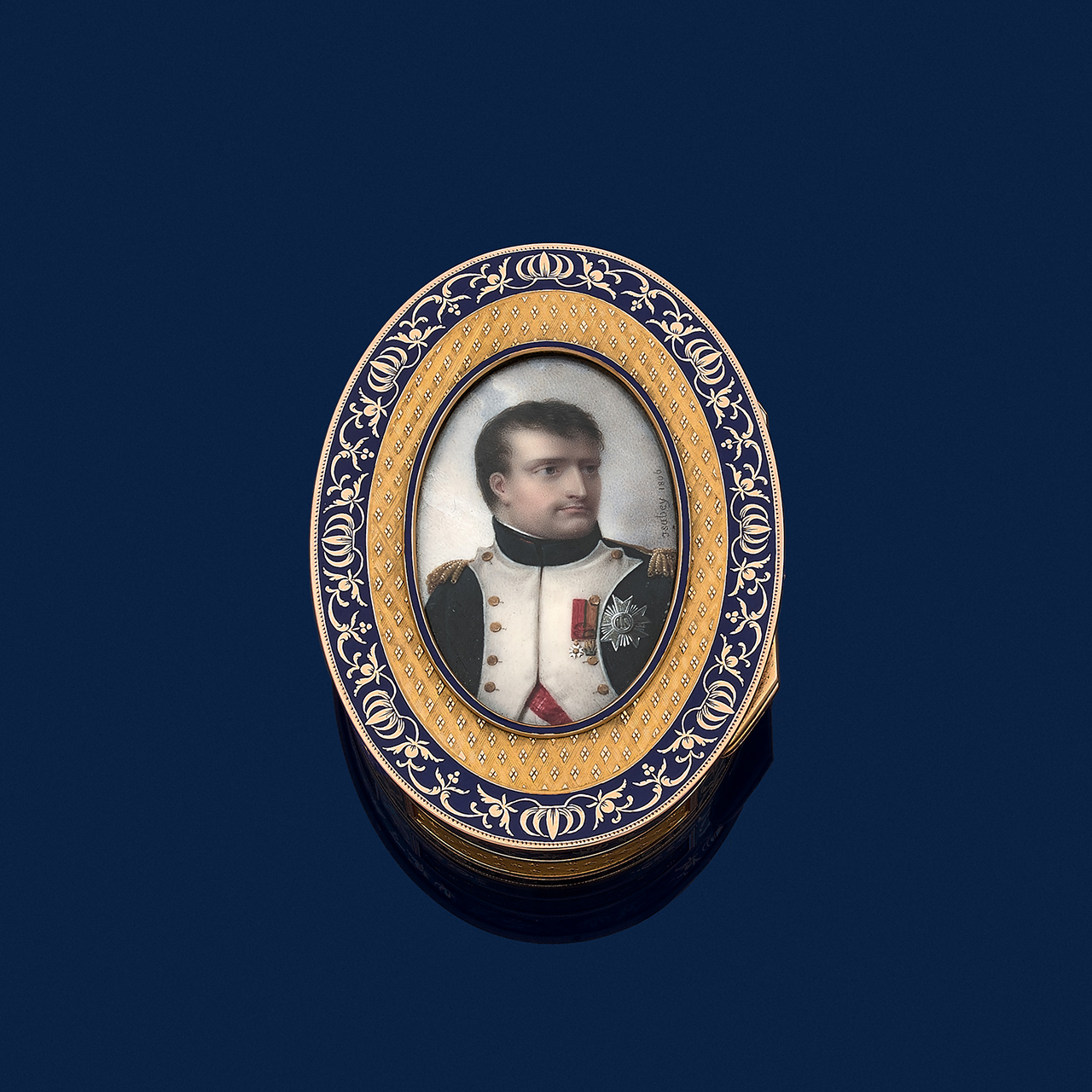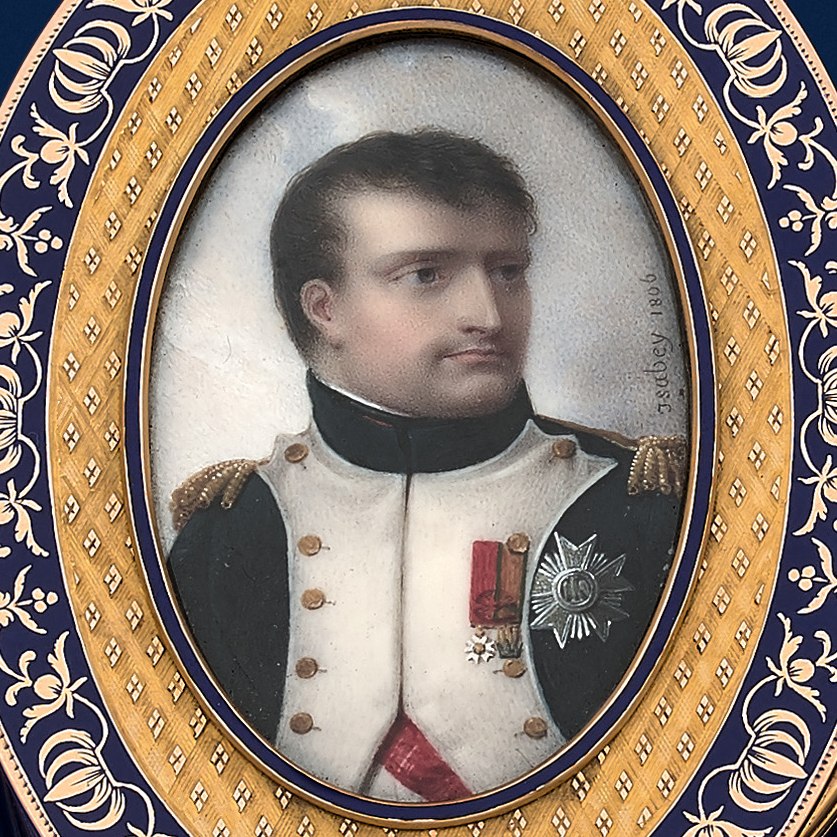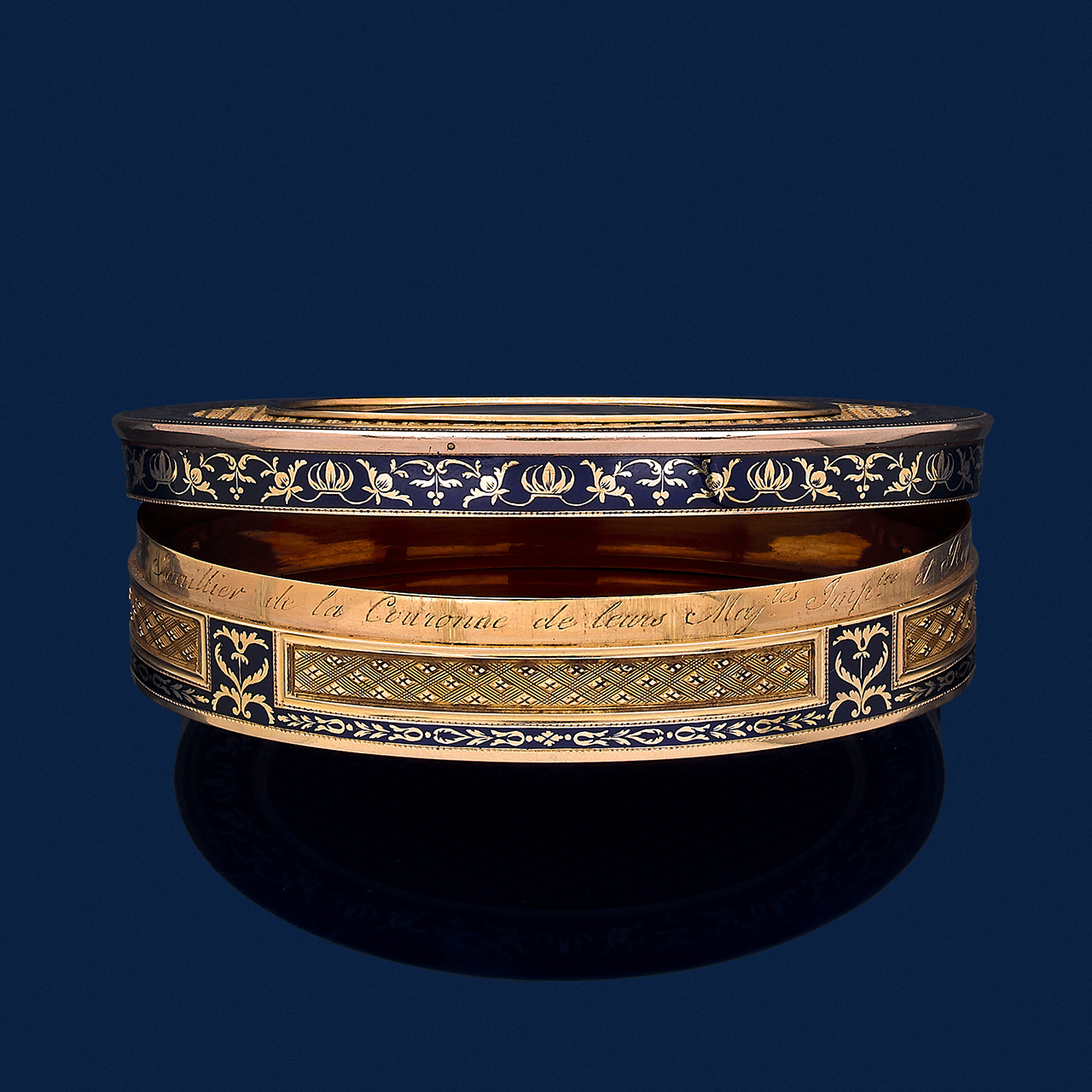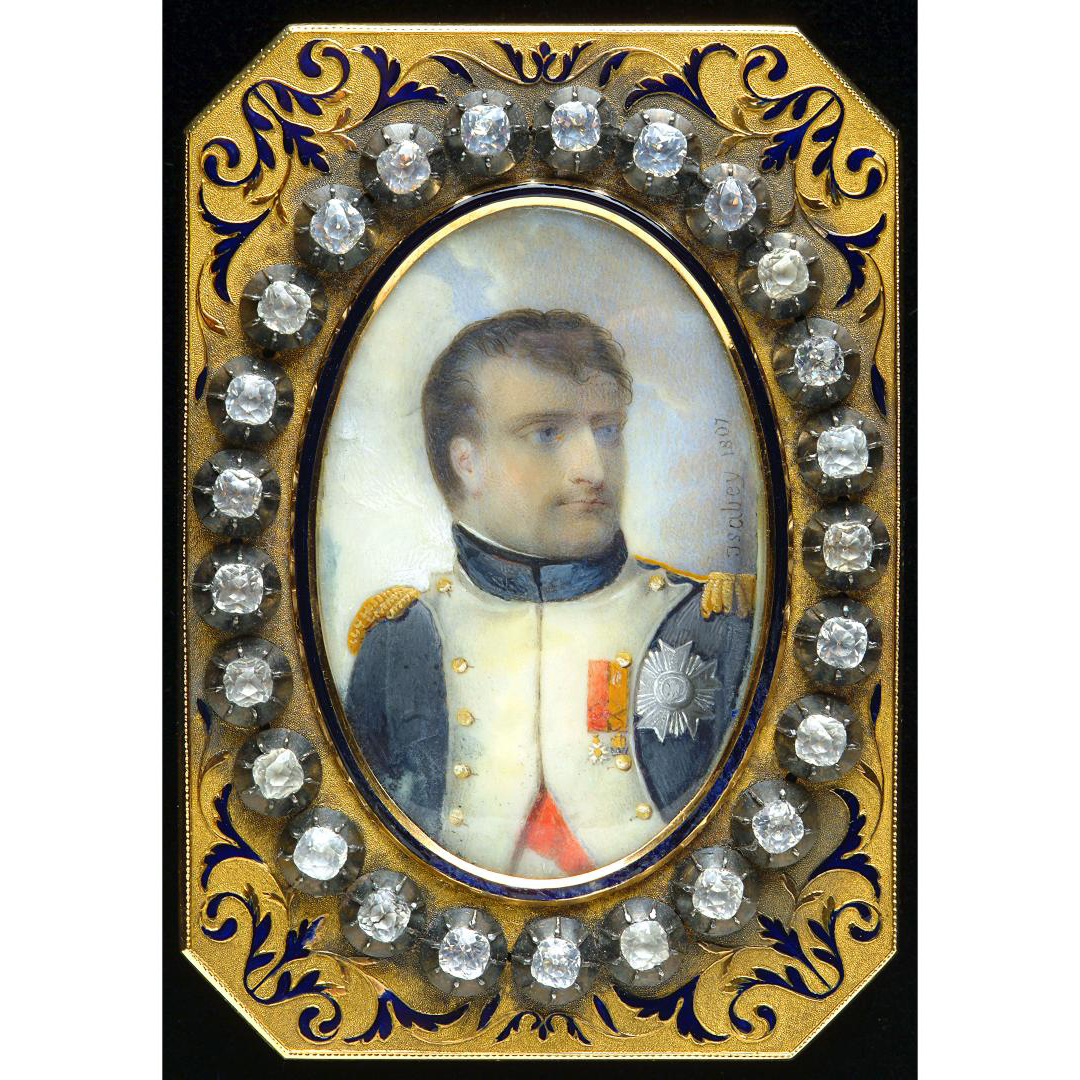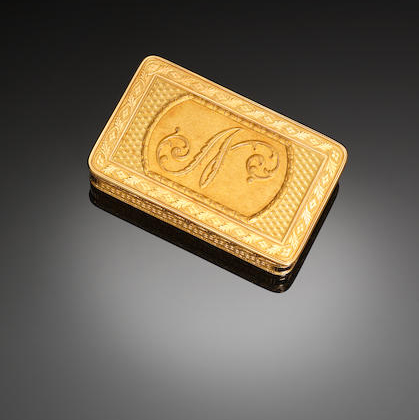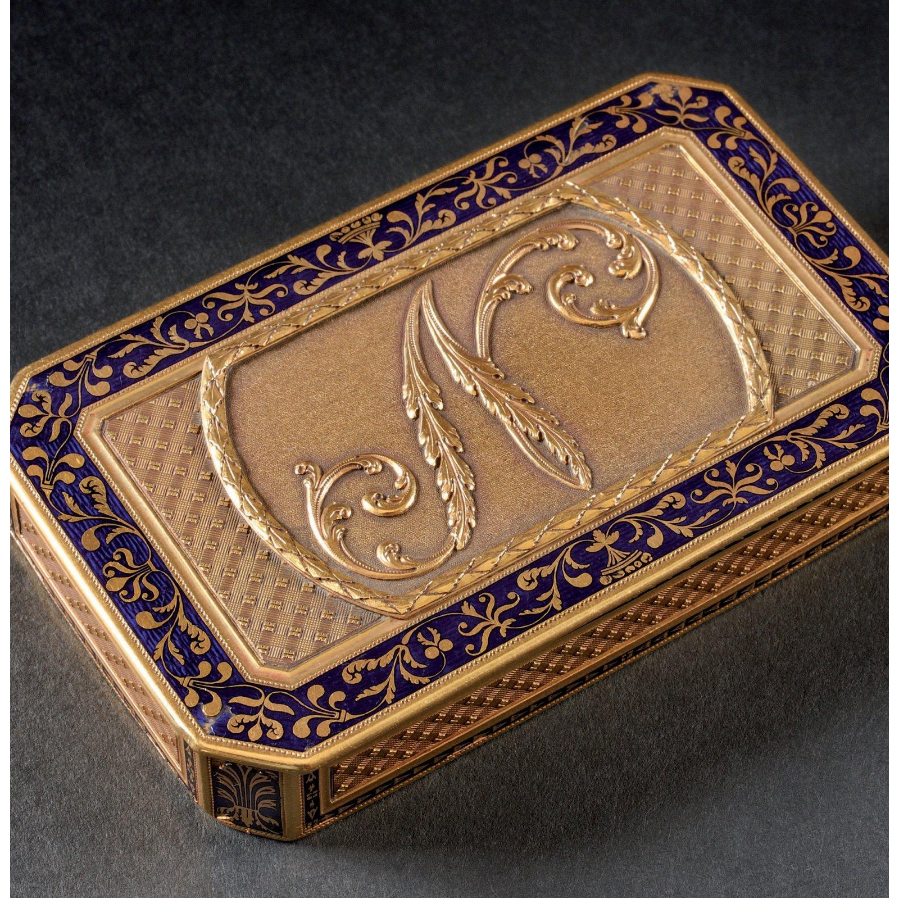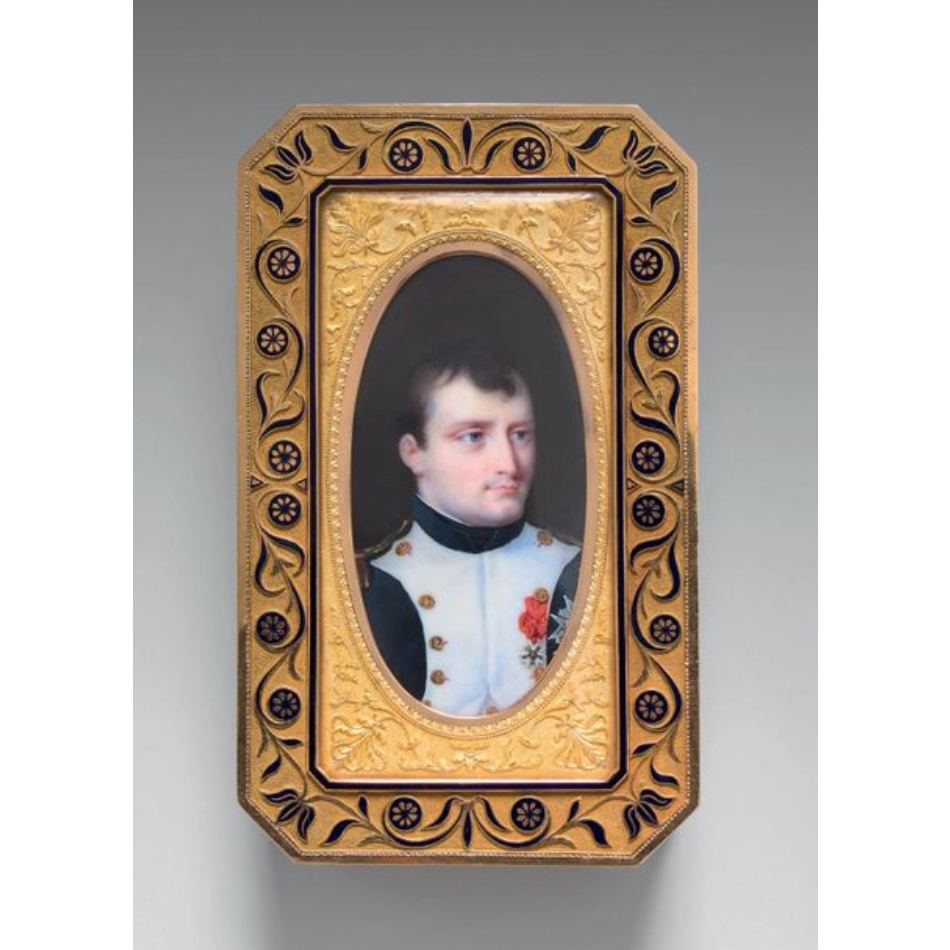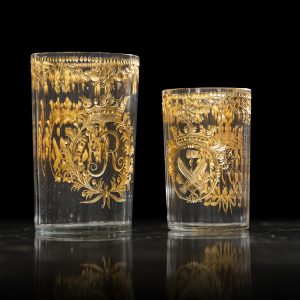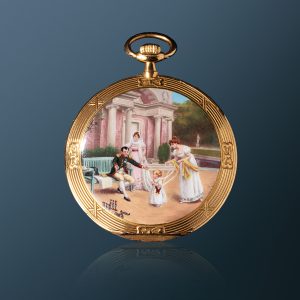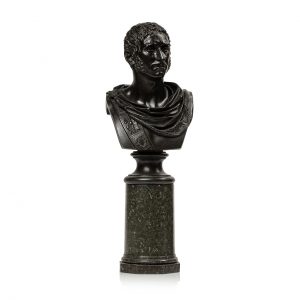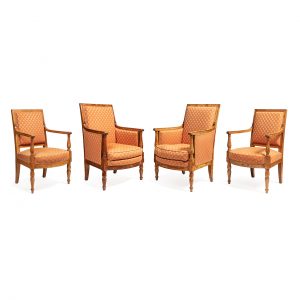Oval-shaped snuff box in 20.5 carats gold chiseled with lozanges in checkerboard, the blue enamelled rims are enhanced with foliage and stylized imperial crowns in gold. The hinged opening lid is inlaid with an oval miniature portrait painted on ivory depicting the Emperor Napoleon in bust, three-quarters to the right, in the uniform of colonel of the foot grenadiers of the Imperial Guard, signed and dated on the right "Isabey 1806".
Engraved on the inner edge of the cover: « Marguerite Joaillier de la Couronne de leurs Maj(es)tés Imp(éria)les et Roy(a)les ».
Very good condition.
Paris, circa 1806-1807.
Goldsmith hallmark of Étienne-Lucien BLERZY.
2nd title baby's head hallmark for Paris, 1798-1809.
This unofficial mark was used by Parisian goldsmiths on their 2e titre gold productions, very often luxury pieces.
L. 8.8 x D. 6.4 x H. 2 cm. Gross weight: 145,2 g.
- Chas collection. E. Dunlap, United Kingdom.
- Private collection, France.
- A gold snuffbox by Marguerite with miniature of Napoleon by Isabey dated 1807, 8.2 x 5.1 cm, is kept at the Musée des Arts Décoratifs du Grand Curtius, Liège (Belgium) (inv. MAAD 10 / Mx / 1216, ill. 1).
- A gold snuffbox by Marguerite with miniature of Napoleon Bonaparte, President of the Cisalpine Republic, by Isabey, is kept at the Museums of Malmaison and Bois-Préau (inv. MM.68.5.1).
- A gold snuffbox with the number “N”, unglazed, by Marguerite and Blerzy, 9 cm, Bonham's sale, London, 23 November 2011, lot no. 14 (auctioned for € 65,832, ill. 2).
- A blue enamelled gold snuff box with the number "N", by Blerzy for Marguerite, 9 x 5.5 x 1.5 cm, Osenat-Binoche & Giquello sale, November 15, 2014, lot n° 185 (auctioned for € 75,000), former collection of the Prince's Palace of Monaco (ill. 3).
- A gold snuff box by Blerzy for Nitot with unsigned miniature of Napoleon, 9 x 5.5 x 2.2 cm, Thierry de Maigret sale, Drouot, June 28, 2019, lot n° 131 (auctioned for € 68,264), old collection Amaury Taittinger (ill. 4).
Our oval gold box, apparently unprecedented on the art market, was made by the jeweler of S.M. L'Empereur, Bernard-Armand MARGUERITE, as attested by the engraved inscription on the edge of the box. Marguerite was installed at 118 rue du Coq Saint-Honoré under the Vase d'Or sign, where he had succeeded his father-in-law Edme-Marie Foncier who had already been Joséphine's jeweler under the Management Board. It was also for the Empress that he had to make some of the pieces of jewelry during the coronation of December 2, 1804.
The miniature which adorns the upper part is signed by ISABEY (1767-1855) and dated 1806. Jean-Baptiste Isabey, originally from Nancy, arrived in Paris in 1785 where he was briefly a pupil of Jacques-Louis David. He quickly became attached to the Beauharnais family and from there quite naturally to the very person of the Emperor. He is widely regarded as the master of 19th century French miniature. There are at the Malmaison Museum a snuff box and a candy box, due to the associated talent of these same two masters, the second representing four portraits of the Beauharnais family was offered by Joséphine to Napoleon.
The miniature portrait then knew an unprecedented vogue, vogue maintained by the revolutionary wars then by the Napoleonic campaigns, each soldier wishing to carry away the memory of the loved one, each woman to keep near her the face of the loved one. . The portraits were painted in watercolor and gouache on a thin sheet of ivory then simply framed under glass, set in the lid of a box - usually a snuffbox for men - or mounted in the form of jewelry - medallion, ring, pin or bracelet for women.
An intimate and sentimental object reserved for private use, the miniature also served to disseminate the official image of sovereigns. From the Consulate, Napoleon entrusted Isabey with a large part of the production of portraits intended to be set on the lids of gift boxes. Inherited from the Ancien Régime, the practice of the diplomatic present had been reinstated by the First Consul in a decree of 7 Thermidor of the year VIII (July 26, 1800): "the customary present of the French government to foreign ministers will be a gold box, bearing the number RF, enriched with diamonds".
After the Coronation, orders from the jewelers Marguerite or Nitot were more numerous in order to satisfy the growing demand for official gifts. Most often referred to as snuffboxes, these boxes corresponded, by their richness, to the presence of a miniature portrait of the Emperor or of his number possibly provided with diamonds, to the quality of the recipient and the value of the service reward.
The miniature portrait was paid 500 F each then, following complaints from Isabella, 600 F from 1808. To respond to the many orders, the artist made work his workshop, reserving the care of executing the faces or contenting himself with signing a portrait already completed by his students. Napoleon, who preferred to be represented in military uniform rather than in coronation costume, expressed strong dissatisfaction in 1807 with the last portraits to come out of Isabey's studio, a reaction quite revealing of the latter's repetitive production.
On May 12, 1806, the Emperor decided that there would no longer be gifts of diamonds and that we would stick to products from French manufactures. From the same year,
we see the sovereign change his mind and order the making of 100 gold snuffboxes for the jeweler Marguerite, some enriched with brilliants, and with a portrait for about a quarter. This expenditure totaled 380,688 F. Marguerite was obliged to subcontract to the goldsmith Etienne-Lucien Blerzy, as our snuffbox shows. Blerzy also worked for Nitot.
The following year, in 1807, the grand marshal of the palace, Duroc, transmitted to the intendant general of the Emperor's house, Daru, such an order, on the same basis. It was executed by the jewelers Marguerite and Nitot et Fils. Bernard-Armand Marguerite, for 50 snuff boxes, received 182,375 F. Étienne Nitot, following a small change, delivered 42 snuff boxes and 12 rings, for 184,391 F. Twenty-five "small portraits" (at 600 francs one ) cost a total of 15,000 F, which cost a total of 381,766 F for the year 1807 (Arch. nat. 0230).
On September 12, 1807, Mr. Desmaisons wrote to the Grand Marshal: “According to your orders, I told the suppliers that they would be paid as and when they were delivered, in order to activate their zeal. I had eleven boxes enriched with brilliants made by MM. Nitot. "There are four portraits with prices of 10,000 and 6,000 F; two with circles and figures of around 6,000 F and five of around 3,000 F; but I have not yet been able to obtain any portraits of Mr. Isabey; the boxes are waiting for them. I have many other painters, but how can I ask them for similarities, without a session? " The other painters in question appear in a memoir of February 2, 1808 in which the following artists are mentioned: Saint (7 portraits at 600 F each), Nitot, Aubry, Gauci, Mimeret, Prosper, Quaglia (Arch. Nat. 0930).
Alphonse Maze-Sencier, The suppliers of Napoleon I and the two empresses, from unpublished documents, Paris, 1893, p. 276.
